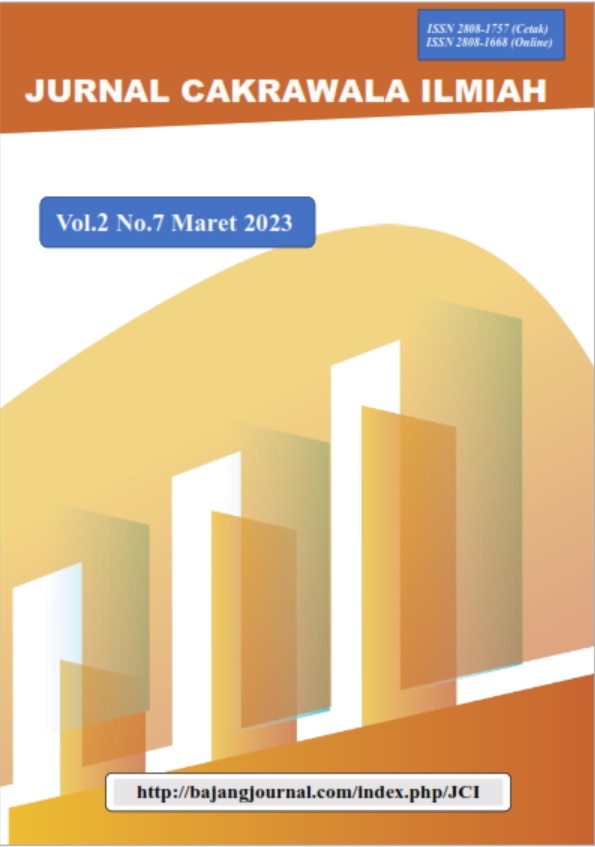FAKTOR-FAKTOR YANG BERHUBUNGAN DENGAN STRES KERJA PADA DOSEN TETAP DI STIKES HARAPAN IBU JAMBI TAHUN 2022
DOI:
https://doi.org/10.53625/jcijurnalcakrawalailmiah.v2i7.5287Keywords:
Lecturer's work stressAbstract
The function of a lecturer is to carry out the tri dharma of higher education, namely education and teaching, research and community service. In addition to carrying out the tri dharma of higher education, lecturers at STIKes Harapan Ibu Jambi do other tasks. The many demands of roles and tasks that must be carried out by a lecturer will have an impact on work stress. The purpose of the study was to find out the factors related to work stress in permanent lecturers at STIKES Harapan Ibu Jambi. This research is a quantitative research with a cross-sectional approach. The study population was all permanent lecturers of STIKES Harapan, Mrs. Jambi with a total sample of 36 people. The sampling technique uses purposive sampling technique. The research instrument is a questionnaire. Data collection techniques use questionnaires. The data were analyzed univariately and bivariately using the chi square test. As many as 55.6% of respondents experienced low work stress , 50.0% of respondents had poor interpersonal relationships, 36.1% of respondents had boring work routines, 100% of respondents had an appropriate sks workload, 36.1% of respondents stated that they were unsatisfactory with career development. Bivariate results show that there is an interpersonal relationship (p = 0.020) with work stress in lecturers. There is no relationship between work routines, sks workload and career development with work stress in lecturers (p>0.05). For this reason, it is recommended that the institution adjust the workload received by a lecturer to the abilities or capacities possessed by the lecturer. Lecturers are expected to maintain good communication, a conducive work environment, and a close sense of family.
References
Anies. (2014). Kedokteran Okupasi. Yogyakarta: Ar-Ruzz Media.
Aprianti, R., & Surono, A. (2017). Interaksi Interpersonal dan Stres Kerja Dosen Tetap di Perguruan Tinggi Swasta. Berita Kedokteran Masyarakat, 34(10), 483–486.
Asih, G. Y., Widhiastuti, H., & Dewi, R. (2018). Stres Kerja. Semarang: Semarang University Press.
Borkowski, N. (2013). Manajemen Pelayanan Kesehatan. Jakarta: EGC.
Dewi, I. R., Hartanti, R. I., & Sujoso, A. D. P. (2016). Hubungan Beban Kerja Mental dengan Stres Kerja Pada Dosen di Universitas Jember. Artikel Ilmiah Hasil Penelitian Mahasiswa, 1(1), 1–5.
Direktorat Jendral Pendidikan Tinggi. (2010). Pedoman Beban Kerja Dosen Dan Evaluasi Pelaksanaan TriDharma Perguruan Tinggi. Jakarta: Direktorat Jendral Pendidikan Tinggi.
Faulina. (2011). Pengaruh Stres Kerja dan Motivasi Kerja terhadap Produktivitas Dosen di Politeknik Negeri Medan. Universitas Sumatera Utara.
Harrianto, R. (2005). Stres Akibat Kerja dan Penatalaksanannya. Jakarta: Universal Medicina.
Kemendikbud. (2021). Keputusan Direktur Jenderal Pendidikan Tinggi Kementerian Pendidikan dan Kebudayaan Nomor 12/E/KPT/2021 Tentang Pedoman Operasional Beban Kerja Dosen. Jakarta: Direktorat Jenderal Pendidikan Tinggi Kementerian Pendidikan dan Kebudayaan.
Munandar, A. S. (2014). Psikologi Industri dan Organisasi. Jakarta: UI Press.
Notoatmodjo, S. (2012). Metodologi Penelitian Kesehatan. Jakarta: Rineka Cipta.
Pertiwi, E. M., Denny, H. M., & Widjasena, B. (2017). Faktor-Faktor yang Berkaitan Bersama Stres Kerja Pada Dosen di Universitas MH. Thamrin Jakarta. Jurnal Kesehatan Masyarakat, 5(3), 260–268.
Pratama, A., Hastono, P. S., & Endarti, A. T. (2021). Faktor-Faktor yang Berkaitan Bersama Stres Kerja Pada Dosen di Universitas MH. Thamrin Jakarta. Jurnal Kesehatan Masyarakat Perkotaan, 1(1), 23–37.
Sucipto, C. D. (2014). Keselamatan dan Kesehatan Kerja. Yogyakarta: Pustaka Baru Press.
Sugiyono. (2012). Metode Penelitian Kuantitatif Kualitatif dan R&D. Bandung: Alfabeta.
Suma’mur, P. K. (2009). Higiene Perusahaan dan Kesehatan Kerja. Jakarta: PT Gunung Agung.
Sunarmi, & Widajanti. (2011). Pengaruh Struktur Organisasi terhadap Kinerja Pegawai dengan Konflik Sebagai Variabel Moderasi. Dinas Sosial Tenaga Kerja dan Transmigrasi Kabupaten Karanganyar. Jurnal Manajemen Sumberdaya Manusia, 5(2), 111–119.
Tarwaka. (2004). Ergonomi Untuk Keselamatan, Kesehatan Kerja dan Produktivitas. Surakarta: UNIBA Press.
Tarwaka. (2015). Ergonomi Industri (Dasar-dasar Pengetahuan Ergonomi dan Aplikasi di Tempat Kerja). Surakarta: Harapan Press.
UU No. 12. (2012). Undang-Undang Republik Indonesia Nomor 12 Tahun 2012 Tentang Pendidikan Tinggi. Jakarta.
UU No. 14. (2005). Undang-Undang No. 14 Tahun 2005 tentang Guru dan Dosen. Jakarta.
Wahjono, S. I. (2010). Perilaku Organisasi. Yogyakarta: Graha Ilmu.
Downloads
Published
How to Cite
Issue
Section
License
Copyright (c) 2023 Jurnal Cakrawala Ilmiah

This work is licensed under a Creative Commons Attribution-NonCommercial 4.0 International License.
















